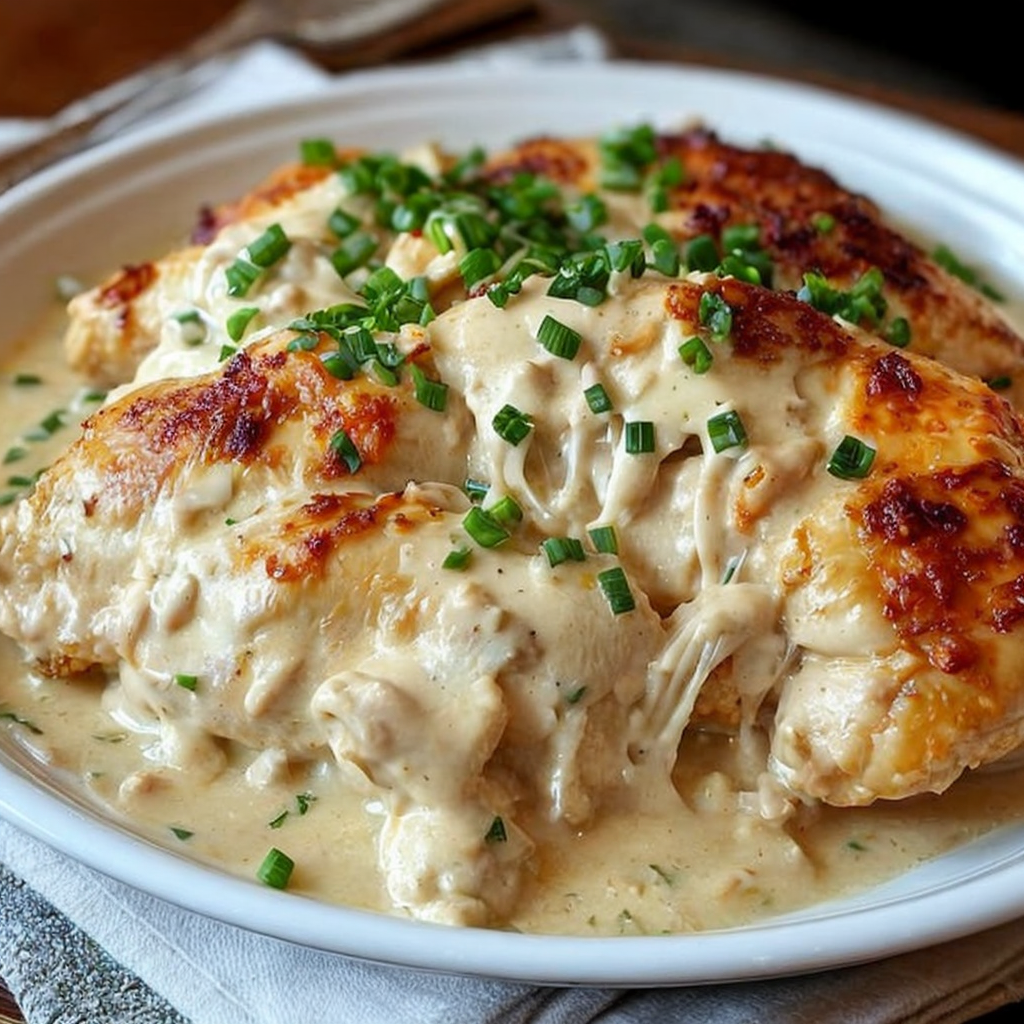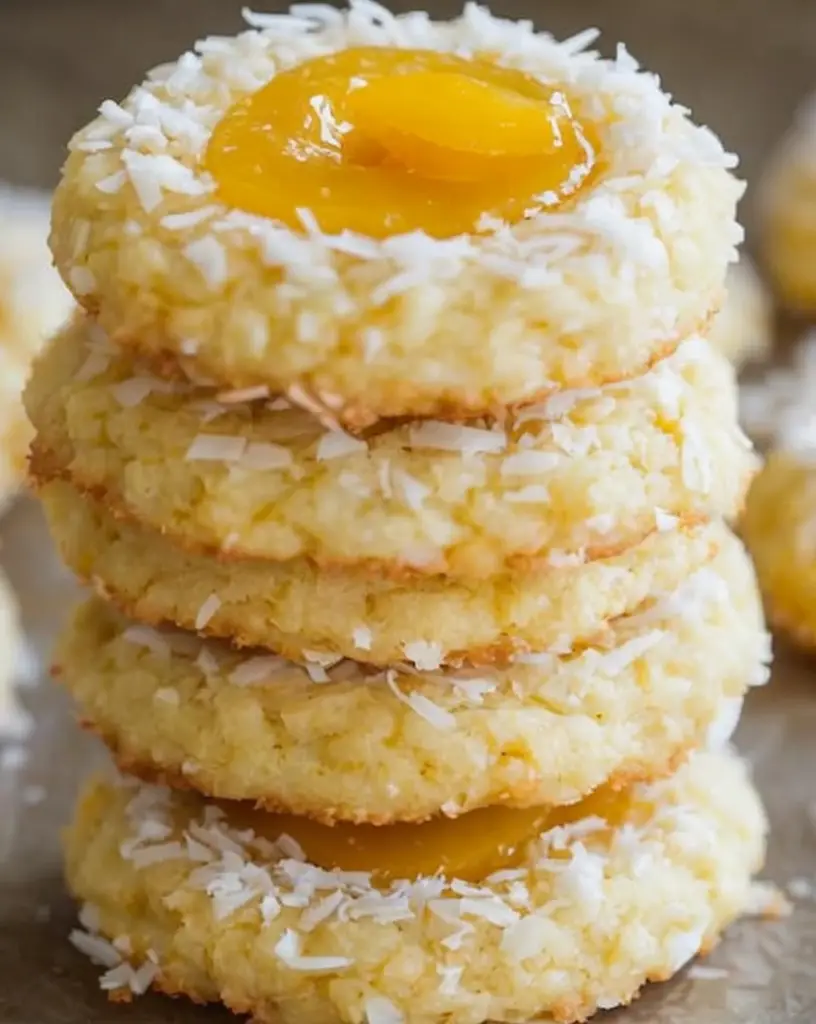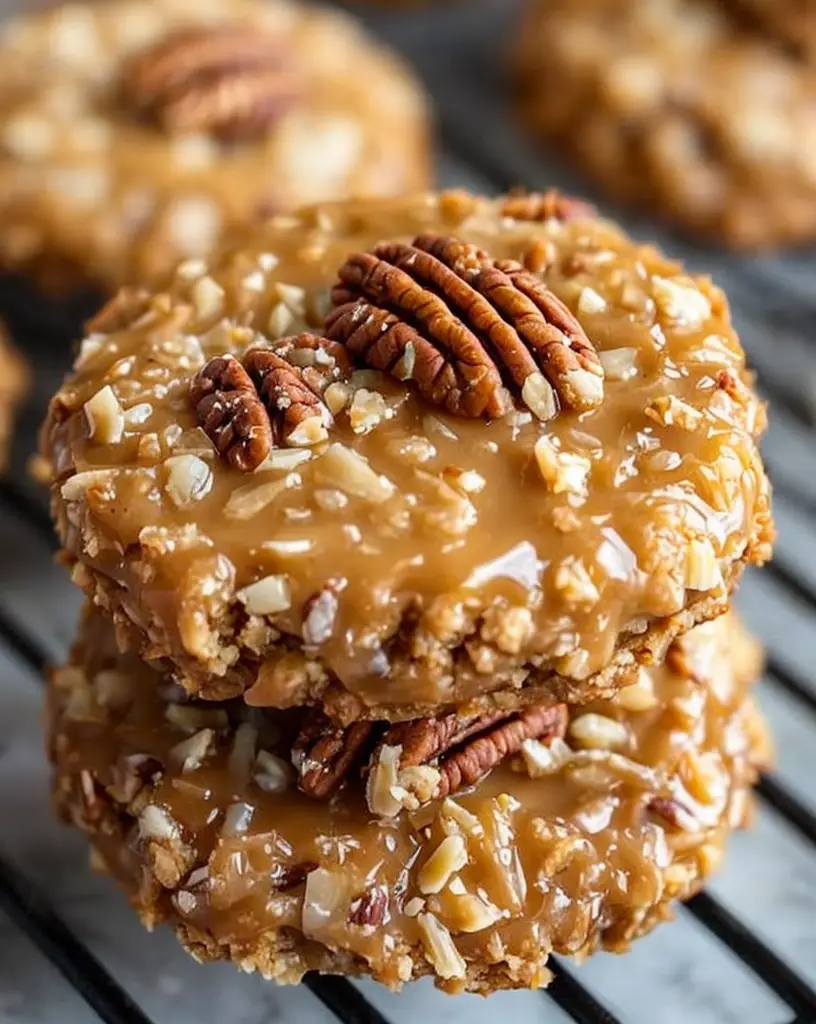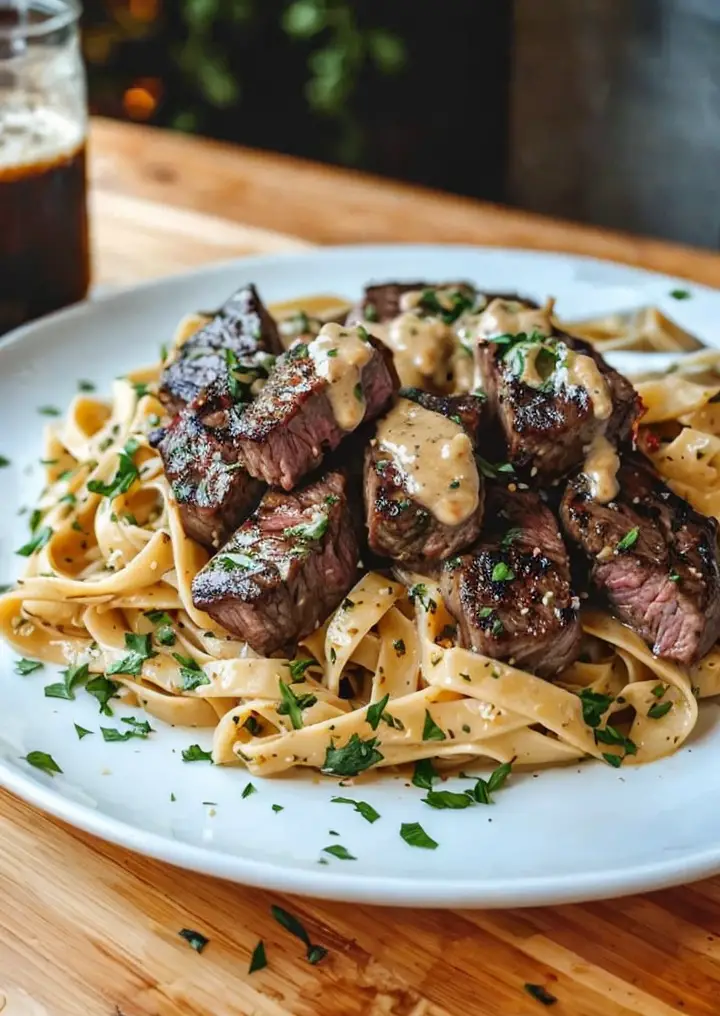Indulgent Million-Dollar Chicken: A Creamy Delight for Your Tastebuds
Indulgent Million-Dollar Chicken is the culinary equivalent of finding a hidden treasure in your pantry. This dish is not just another chicken recipe; it’s a delightful marriage of creamy goodness and exquisite flavors. Imagine juicy chicken breasts enveloped in a luxurious creamy sauce, punctuated with the richness of cheese and herbs. Each bite offers a comforting warmth that calls you to gather with family and friends, making it the perfect centerpiece for any meal.
What truly sets this recipe apart is its effortless blend of gourmet taste and simplicity. It requires minimal prep yet delivers an impressive outcome. The creamy sauce creates a mouthwatering experience, while layers of flavor—from the savory garlic to the peppery notes of thyme—will have everyone asking for seconds. Perfect for a bustling weeknight or a relaxing Sunday dinner, this Million-Dollar Chicken promises to elevate your dining experience to new heights.
Quick Recipe Highlights
- Flavor Profile: The combination of creamy cheese, garlic, and thyme creates a savory and rich flavor that enchants the palate.
- Texture: The dish features tender, juicy chicken paired with a velvety sauce that coats each bite, offering a satisfying mouthfeel.
- Aroma: The intoxicating aroma of sautéed garlic and herbs wafts through your kitchen, enticing everyone at home.
- Visual Appeal: The creamy sauce glistens on the golden-brown chicken, creating a visually stunning dish that looks as good as it tastes.
- Skill Level Needed: This recipe is approachable for beginners, requiring basic cooking skills and techniques.
- Special Equipment: You’ll need a skillet, a spatula, and a measuring cup for this easy recipe.
Recipe Overview
- Difficulty Level: This medium difficulty meal allows for culinary exploration, giving beginners a chance to build confidence whilst delighting seasoned cooks seeking an impressive yet simple dish.
- Category: This recipe fits beautifully into main courses, particularly for dinner or special occasions, providing a hearty meal option.
- Cuisine: While it draws inspiration from American comfort food, the use of creamy ingredients gives this dish a touch of European flair.
- Cost: An approximate cost of $15-$20 makes this recipe affordable, especially when feeding a family or a small gathering.
- Season: Any time of year is perfect for this dish, whether enjoyed in a cozy winter meal or a light summer gathering.
- Occasion: Ideal for family dinners, special occasions, or as a comforting dish for guests, the Indulgent Million-Dollar Chicken fits perfectly into any culinary context.
Why You’ll Love This Recipe
The taste and texture of Indulgent Million-Dollar Chicken are irresistible. The tender chicken breast, paired with a rich and creamy sauce, creates an explosion of flavors in your mouth. Each bite feels indulgent yet comforting, making it a go-to comfort food for any occasion. Not only does it deliver on taste, but the sauce also provides a luxurious texture that makes the dish feel special.
Preparation is straightforward, which will delight busy home cooks. The combination of a short prep time and quick cooking means that you can have dinner on the table in under an hour without compromising on flavor. This recipe beautifully balances convenience and gourmet, ensuring that even the busiest nights can feel indulgent.
From a nutritional standpoint, chicken is a great source of lean protein, essential for building and repairing tissue. This dish can easily provide a nutritional boost when paired with vegetables like broccoli or spinach. The creamy sauce further enriches the meal, especially when using quality ingredients that provide flavor without excessive calories.
Socially, this recipe shines when serving guests or family. Its impressive appearance and delightful aroma invite conversation and enjoyment around the dining table. Whether you’re celebrating a birthday or just enjoying a Friday night in, this meal fosters sharing and connection, making it perfect for gatherings.
Lastly, the cost-effectiveness of this dish compared to fine dining makes it accessible for many. Transforming simple ingredients into a luxurious experience means you can enjoy restaurant-quality meals at home without breaking the bank.
Historical Background and Cultural Significance
The origins of this recipe may not be precisely documented, but it’s clear that creamy chicken dishes have been popular in many cultures, especially in the Americas. The inspiration behind the Indulgent Million-Dollar Chicken stems from a blend of classic American flavors with modern cooking techniques, making it relevant and appealing today.
Culturally, comfort food like this chicken recipe plays an essential role in family traditions. It evokes memories of gathering around the dinner table to share food, laughter, and stories. Over time, such recipes have evolved from simple home-cooked meals to gourmet renditions, allowing home cooks to impress their loved ones.
The evolution of creamy chicken recipes has seen variations across regions, with each culture putting its unique spin on the dish. From creamy French coq au vin to the Italian pollo al limone, the common theme of tender chicken and rich sauces prevails, demonstrating the adaptability of this beloved meal.
Regional variations can include the addition of local herbs, spices, or even vegetables that highlight seasonal ingredients. This adaptability allows the Indulgent Million-Dollar Chicken to remain a relevant and delightful option for dining occasions throughout the year.
Ingredient Deep Dive
Chicken is the star ingredient of this recipe. Its popularity can be traced back to its abundance and versatility in many culinary traditions worldwide. Nutritionally, chicken is a lean protein source that aids muscle growth and repair. When selecting chicken breasts, look for those that are free-range and organic for better flavor and quality. Store fresh chicken in the refrigerator and use it within 1-2 days or freeze for later use.
The creamy sauce often features heavy cream or sour cream, which not only adds richness but also contributes to the smooth texture of the dish. Cream has a long history in cooking, often used in European cuisine to create decadent sauces. For added nutrition without sacrificing flavor, consider substituting heavy cream with Greek yogurt, which is lower in fat and high in protein.
Herbs like thyme and garlic enhance the flavor profile significantly. Thyme has been revered for centuries due to its culinary uses and medicinal properties. Always choose fresh thyme over dried for the best flavor and aroma. Garlic adds depth to the dish; select firm bulbs with no sprouting to ensure freshness. Store garlic in a cool, dry place, and use it within a few weeks for peak flavor.
Common Mistakes to Avoid
- Not seasoning the chicken adequately can lead to bland flavors. Always season your protein generously with salt and pepper before cooking.
- Overcooking the chicken can result in a dry texture. Use a meat thermometer to check for doneness—165°F is the target temperature.
- Skipping the resting period after cooking can cause juices to escape when you slice the chicken, leading to a dry meal.
- Using low-quality cream will affect the overall flavor and texture of the sauce; opt for high-quality heavy cream for the best results.
- Using too much flour in the sauce can create a pasty texture; always start with a small amount and adjust as needed.
- Not allowing the garlic to sauté before adding other ingredients can result in a raw garlic flavor; always let it cook briefly until fragrant.
- Overcrowding the pan while cooking chicken can lead to steaming rather than browning, inhibiting the flavor.
- Neglecting to taste and adjust seasoning towards the end of cooking can lead to unbalanced flavors. Always make adjustments as necessary.
Essential Techniques
Perfectly searing chicken requires heat management and timing. Begin with a hot skillet to achieve a golden-brown crust. Allow the chicken to sear undisturbed for the recommended time to establish a flavorful crust. If you encounter sticking, it means the chicken isn’t ready to flip just yet.
Creating a luxurious sauce involves deglazing the pan after searing the chicken. Using chicken broth helps lift any caramelized bits from the bottom of the skillet, adding depth to your sauce. Stir continuously to avoid lumps and ensure a smooth finish.
Properly emulsifying your cream helps integrate it seamlessly into the sauce. Begin by adding a little of the hot liquid to the cream before combining; this helps prevent curdling. Whisk continuously and watch for visual cues—the sauce should thicken but remain pourable.
Pro Tips for Perfect Indulgent Million-Dollar Chicken
Utilize fresh herbs for the best flavor profile—fresh thyme elevates the dish’s aromatic experience. Take care not to chop them too finely, allowing their essence to infuse the sauce.
Try marinating the chicken in a mixture of olive oil, lemon juice, and herbs for an added flavor boost. Opt for at least half an hour before cooking for optimum tenderness.
Always allow your chicken to reach room temperature for even cooking. This simple step ensures that your chicken cooks at a consistent temperature for perfectly juicy results.
Serve the dish over a bed of rice or pasta to soak up the delightful sauce. This not only enhances the meal but also creates a beautiful presentation on the plate.
Consider garnishing with parsley or fresh thyme to add color and a touch of freshness. The finishing touches can transform the overall appeal of the dish.
For an additional crunch, finish your dish with toasted breadcrumbs before serving. This gives a delightful texture that contrasts beautifully with the creamy sauce.
Variations and Adaptations
For regional variations, consider adding ingredients like sun-dried tomatoes or olives for Mediterranean flair. Alternatively, flavors such as curry or coconut can transform the dish into a tropical delight.
Seasonal adaptations may include adding vegetables like asparagus or peas in the spring for a fresh twist, or incorporating root vegetables in the fall for a cozy feel.
Dietary modifications could involve using plant-based chicken substitutes for a vegan option, adjusting the recipe without sacrificing flavor or satisfaction.
Flavor variations may include a splash of white wine in the sauce for a more complex taste. Additionally, experimenting with other herbs like rosemary or oregano can yield delightful results.
Exploring texture modifications can involve incorporating sautéed mushrooms for a meaty contrast or adding spinach for an extra layer of nutrition.
For presentation alternatives, serve the dish in individual cast-iron skillets or rustic bowls topped with microgreens for a visually appealing touch at dinner parties.
Serving and Presentation Guide
When plating your Indulgent Million-Dollar Chicken, ensure that the chicken is the focal point. Place it gently on a bed of fluffy rice or creamy mashed potatoes.
Consider garnishing with fresh herbs to elevate the dish’s aesthetic appeal. A sprinkle of freshly cracked black pepper can add an inviting touch.
Traditional accompaniments might include a side of roasted vegetables or a fresh green salad. Modern servings can explore fun additions, such as crispy breadsticks or garlic knots.
Temperature-wise, serve the chicken hot, allowing the creamy sauce to warm the accompanying sides. This creates a harmonious dish that provides comfort in every bite.
For portion control, consider slicing the chicken into medallions and arranging them artfully with the sauce drizzled over the top, giving a restaurant-quality appearance.
Wine and Beverage Pairing
When selecting wine to accompany your Indulgent Million-Dollar Chicken, a chilled Chardonnay or a light Pinot Grigio complements the creamy texture beautifully. These wines’ acidity cuts through the richness, enhancing the overall dining experience.
For non-alcoholic alternatives, consider serving sparkling water with a slice of lemon for a refreshing palate cleanser. Alternatively, a lightly brewed iced tea can provide a refreshing contrast.
Coffee or tea can be considered as after-dinner options, allowing guests to unwind post-meal. A well-brewed cup of coffee can enhance dessert flavors should you choose to serve something sweet afterward.
When serving wine, ensure that it’s at the right temperature—white wine should be chilled, while red options can be slightly cooler than room temperature to maintain freshness.
Serving suggestions may include decanting the wine ahead of time to enhance aromas, inviting your guests to taste the nuances alongside their meal.
Storage and Shelf Life
To store leftover Indulgent Million-Dollar Chicken, place it in airtight containers and refrigerate for up to three days. Make sure to cool it completely before transferring it to avoid condensation.
When it comes to freezing, ensure you use freezer-safe containers for optimal storage. The dish can last for up to three months when frozen, but note that the cream sauce may change texture upon thawing.
Signs of spoilage include a sour smell or a change in color. Always taste a small portion before reheating if you are unsure about its freshness.
Reheating should be a gentle process—use low heat on the stovetop, adding a splash of cream or broth to restore its creamy consistency if needed.
When reheating in the microwave, use a covered dish with a microwave-safe lid. Stir occasionally to promote even heating and avoid hot spots.
Make Ahead Strategies
For best results, prep indulgent Million-Dollar Chicken components ahead of time. Marinate the chicken overnight for an infusion of flavor and tenderness.
You can prepare the creamy sauce in advance and store it separately. Reheat it gently on the stovetop while cooking the chicken to ensure it blends smoothly.
Set aside your chosen vegetables, chopping them in advance for a quicker cooking process when it’s time to put the dish together.
Assess quality at each step, ensuring meats, sauces, and vegetables remain fresh and flavorful until serving. Freezing components individually can help retain clarity in texture and taste.
Consider adding fresh elements—such as herbs or greens—just before serving for the best visual appeal and nutritional benefits, ensuring a lively presentation.
Scaling Instructions
For halving the recipe, simply divide all ingredients and cooking times by two, ensuring that any cooking methods remain consistent for optimal flavor.
Doubling or tripling the recipe requires larger pots to accommodate multiple servings. Adjust cooking times slightly, as larger amounts may require longer to reach the correct internal temperature.
Keep an eye on oven or stovetop temperature adjustments depending on the increase in quantity; monitor sauces and ensure thorough mixing.
When scaling, consider that allowing extra time for preparation, such as marinating, can enhance flavors even more when cooking in larger batches.
Storage tips remain consistent—store in larger containers if needed to accommodate increased quantities without compromising freshness.
Nutritional Deep Dive
In assessing the macros of Indulgent Million-Dollar Chicken, the dish typically offers a balanced ratio of protein and fats, thanks primarily to the chicken and cream.
Micronutrient analysis sheds light on beneficial elements, such as B vitamins from chicken, which are essential for energy metabolism and brain function.
Incorporating vegetables can elevate the fiber content, beneficial for digestion and overall health. The addition of greens can transform the meal into a well-rounded nutritional powerhouse.
Health benefits of this recipe include its ability to provide essential nutrients while still indulging the senses with rich flavors. The complexity of the sauce can encourage further vegetable intake.
Portion control is vital; understanding serving sizes helps with weight management while still enjoying indulgent meals. Aim for balance when combining with sides to create a nutritionally sound dinner.
Dietary Adaptations
For a gluten-free adaptation, simply ensure that all sauces and toppings are free from wheat-related ingredients. Make the sauce using cornstarch instead of flour for thickening.
Dairy-free versions can utilize coconut cream or cashew cream to create a similar texture and flavor profile without lactose.
Vegan adaptations involve replacing chicken with hearty vegetables or tofu, while maintaining the cream sauce’s richness using blended nuts or plant-based milk.
Low-carb variations may substitute high-carb sides like rice with cauliflower rice or sautéed vegetables. These adjustments can retain the dish’s essential flavors while reducing carbs significantly.
Keto adaptations recommend using full-fat dairy elements and avoiding starchy vegetables, allowing this creamy chicken to fit into a low-carb dietary lifestyle.
For those following the paleo diet, omit any processed ingredients and utilize fresh herbs and seasonal vegetables to make the meal compliant while still delivering on taste.
Troubleshooting Guide
If you encounter texture issues with your sauce being too thick, add a little chicken broth or water to loosen it up gradually until the desired consistency is reached.
For flavor balance, consider if it’s too bland; a little pinch of salt or acidity with lemon juice can liven up the dish effectively. Always taste before serving.
Temperature problems may arise if the chicken undercooks; use a meat thermometer to avoid any surprises and guarantee safe cooking.
Equipment challenges can arise from inadequate pans; ensure you use a heavy-bottomed skillet for even heat distribution, which is crucial when searing chicken.
Ingredient substitutions may lead to unexpected flavor changes; keep essential spices on hand to ensure you don’t compromise on the dish’s intended profile.
If timing between steps becomes problematic, it’s worth setting up a staging area where sauces are easily prepped ahead and cooked later for efficiency.
Recipe Success Stories
Community feedback often highlights the creamy flavor and ease of preparation as standout features, prompting repeat requests for this dish at family gatherings.
Variation successes include readers sharing their twists, like adding mushrooms or different herbs, proving the dish’s adaptability while retaining its core appeal.
Adaptation stories reveal how busy weeknight meals can align perfectly with this recipe, uniting families around a comforting and indulgent dinner effortlessly.
Photography tips have been a highlight, where readers recommend capturing the shiny sauce glistening over the chicken to entice those scrolling past.
Sharing personal stories of creating this dish for special occasions adds a layer of communal joy. The recipe’s flexibility allows it to fit various traditions and celebrations.
Frequently Asked Questions
Can I use other meats for this recipe? Yes, while chicken is traditional, you can substitute with pork or turkey. Ensure that the cooking times are adjusted as these proteins have different compositions.
How do I store leftovers? Store leftovers in an airtight container in the refrigerator for up to three days. Reheat gently when ready to enjoy.
Is this recipe suitable for meal prep? Absolutely! You can prepare components ahead of time, making mealtime even easier.
Can I make this dish spicy? Certainly! Adding red pepper flakes or diced jalapeño during cooking can give the dish a delightful kick.
What sides pair well with this chicken? This indulgent dish pairs beautifully with rice, mashed potatoes, or a fresh green salad.
Is the creamy sauce necessary? While it is the signature of the dish, a tomato-based sauce or herb-infused broth could offer a lighter alternative.
Can I reheat the dish in the microwave? Yes, but it is best reheated on a stovetop over low heat to prevent the sauce from separating.
How can I make this recipe gluten-free? Use cornstarch or gluten-free flour in place of regular flour for the sauce adjustment.
What’s the best way to thicken the sauce? Gradually add flour or cornstarch mixed with water to the simmering sauce until you reach the desired consistency.
Can I freeze the creamy chicken? Yes, but the creamy sauce may change texture when thawed. Make sure to reheat gently to restore its consistency.
Additional Resources
Consider exploring related recipes for different chicken dishes or creamy casseroles to expand your culinary repertoire. Technique guides can help enhance your cooking skills, while ingredient information will deepen your understanding of what goes into your meals.
For equipment recommendations, ensure you have the right tools to make cooking enjoyable and efficient. Seasonal variations can inspire creativity with ingredients you may want to experiment with throughout the year.
Join the Conversation
We invite you to share your experiences with the Indulgent Million-Dollar Chicken on social media! Use our tag to highlight your beautiful creations and connect with other cooking enthusiasts. Don’t forget to leave your recipe reviews or suggestions for variations that you’ve tried, as community engagement makes this culinary journey even more rewarding.
The Recipe
Indulgent Million-Dollar Chicken
Serves: 4 servings
Prep Time: 15 mins
Cook Time: 30 mins
Total Time: 45 mins
Kitchen Equipment Needed
- Skillet
- Measuring cups
- Spatula
- Meat thermometer
Ingredients
- 4 chicken breasts
- 1 cup heavy cream
- 1 cup chicken broth
- 1 cup shredded cheese (cheddar or your choice)
- 2 tbsp olive oil
- 4 cloves garlic, minced
- 1 tsp fresh thyme, chopped
- Salt and pepper to taste
- 2 tbsp flour or cornstarch (optional, for thickening)
Directions
- Heat olive oil in a skillet over medium heat.
- Season chicken breasts with salt and pepper, then add them to the skillet.
- Cook for 6-7 minutes on each side until golden brown and fully cooked, then remove and set aside.
- In the same skillet, add minced garlic and thyme, sautéing for about 1 minute until fragrant.
- Pour in heavy cream and chicken broth, stirring to combine.
- If desired, mix flour or cornstarch with a bit of water to create a slurry, then add it to the skillet to thicken the sauce.
- Return the chicken to the skillet and sprinkle with cheese, allowing it to melt into the sauce.
- Serve hot, garnished with fresh herbs and alongside your favorite sides.
Recipe Notes
- Feel free to add vegetables like spinach or mushrooms for added nutrition.
- Experiment with different types of cheese for unique flavors.
- Can be made ahead and reheated for convenience, although sauce texture may vary.



